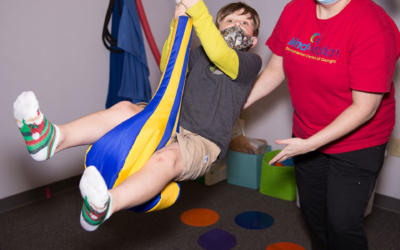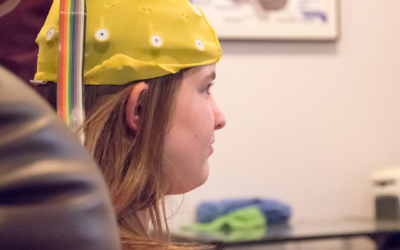
 By: Elizabeth Yanow, PT, DPT
By: Elizabeth Yanow, PT, DPT
Does My Student Need an IEP or 504 Plan, and What is the Difference?
As parents, we want to see our children succeed whether this be in school, in the community, and or at home. But what happens when you are left watching your child struggle at school? Is your child falling behind, getting poor grades, being teased? Do you suspect a learning disability? Has your child already been diagnosed with one? If so, they may qualify for an Individualized Education Plan (IEP) or a 504 Plan to support their needs for learning. These plans provide assistance and protect individuals with disabilities in programs, such as schools, that receive federal funding. These plans will support the child/student from pre-K to 12th grade. For both plans, the school generally conducts an evaluation to determine the disability or impairment affecting participation and inclusion in school functions and to determine the best accommodations to implement. Many people are involved in such meetings including you, the parent/caregiver. This is a long process, but absolutely worth it to provide your child with what they need. So, where to start.
DOCUMENT
When you start to get that feeling that something is not right and you notice your child struggling, start keeping a record. Use folders to keep track of your child’s grades, quizzes, and email correspondences with the teachers about behavior. All of this information will help when you meet with the school to determine accommodations that may help your child succeed. It is also important to record things your child says as well, for example how they respond and react to their hurt feelings if they are being picked on, reports of not wanting to go to school etc.
SCHEDULE A MEETING WITH THE TEACHER
Teachers are able to provide strategies and insights into what may be going on into the classroom. Additionally, they will be able to help problem solve and provide suggestions that may help resolve the issues without going any further. When preparing for the meeting, make sure you bring with you the documents you have kept regarding your concerns. Take your child with you to the meeting, and make sure his or her strengths are discussed as well. Ask detailed questions about academic performance. How does your child’s behavior interfere with his or her ability to successfully complete work and participate in class? It is important to remember that teachers work with all types of children and have many ideas on how to problem solve behaviors, organizational skills, homework challenges, and more. Leave the meeting with the commitment to continue communicating. How will you communicate? Emails work best when keeping track of and documenting the process as well as the progress. Also keep in mind, it can take up to 60 days for the school to determine eligible accommodations, thus communication with the teacher is very important.
DIAGNOSIS
You are NOT REQUIRED to have a diagnosis to apply for school services and accommodations. However, it can be extremely helpful in the decision-making process. Additionally, receiving a diagnosis from a medical provider can make your child eligible for therapy services outside of school that can improve participation and behavior in community related and home environments.
It is important to select the right provider to diagnose your child. Some providers like a neuropsychologist or developmental pediatrician, have more experience in areas of learning disabilities. At Mind and Motion, we have two neuropsychologist’s who are experienced in comprehensive evaluations for ADHD, Autism, learning disabilities, and more! You can read Dr. David Cantor’s bio here and Dr. Alcuin Johnson’s bio here.
Once a diagnosis is made, ask the doctor to provide you with a detailed letter of their findings and reasons accommodations need to be implemented at school. This letter should be done on the doctor’s letterhead. Then add this letter to your documents to be submitted during the evaluation for services at school.
REQUEST A SCHOOL ASSESSMENT
So, the plan that was implemented with the teacher isn’t working. Now what do I do? It’s time to apply for accommodations. It is important to understand that services are not always given and the assessment completed by the school is not assessing your child for a medical diagnosis. The first step is to send a letter to the district's head of special education with a copy to your child’s principal.
- Ask your therapist for help with a sample letter. Many of our therapists at Mind & Motion are available to help or know someone who can.
- Check the guidance counselor’s office, they may be able to provide advice as well.
- Explain the challenges your child has faced.
- Explain the technique’s you and the teacher have implemented and why they have not worked.
- Request an assessment for a suspected learning disability.
- Send the letter certified mail.
EVALUATION and ASSESSMENT Completed by the School
Next you will sign a consent form allowing the school to evaluate your child. From this moment, the school has 60 days to complete an evaluation. This may include a conference where parents and teachers come together to provide information regarding the challenges and needs of your child. This is where those documents you have been saving come into play again! The school will then complete an evaluation to determine if services are indicated. Generally speaking, the school will assess:
- Health and development
- Intellectual abilities
- Motor abilities
- Vision
- Hearing
- Language
- Function
- General abilities
- Academic performance
- Social behaviors
- Interests and or self help
- Vocational abilities
THE DECISION: IEP or 504
Once the evaluations are complete, another meeting will be held regarding the decisions for accommodative services. If the school determined your child to be ineligible for services, a meeting will not be held and they will notify you by letter. Otherwise, a decision has been made for your child to receive services through either the 504 plan or an Individual Education Plan (IEP).
IEP FACTS 
- The IEP is supported under the IDEA Act (Individuals with Disabilities Education Act) to provide special education services. To qualify for services under the IDEA Act, and receive an IEP, your child must have one or more of these 13 disabilities listed below. The identified disability must impact the child’s ability to learn/participate/and benefit from a general education.
- Specific learning disability (dyslexia, dyscalculia, Written expression disorder)
- Other health impairment (conditions that limits a child’s strength, energy, or alertness)
- Autism Spectrum Disorder
- Emotional Disturbance (ex: bipolar disorder, OCD, depression, schizophrenia, anxiety)
- Speech or Language impairment
- Visual impairment including blindness
- Deafness
- Hearing Impairment (hearing loss not covered by deafness
- Deaf-blindness (children with both hearing and vision loss)
- Orthopedic impairment
- Intellectual disability
- Traumatic brain injury
- Multiple disabilities
 504 FACTS
504 FACTS
- The 504 Plan was established under the Rehabilitation Act of 1973. The Rehabilitation Act established protection for individuals with disabilities in federally funded programs. These programs include public schools and higher education institutions. The Rehabilitation Act defines disability as something that limits one or more of these major life functions or activities.
- Walking
- Seeing
- Hearing
- Speaking
- Breathing
- Learning
- Working
- Caring for oneself
- Performing manual tasks
- Eating
- Sleeping
- Standing
- Lifting
- Bending
- Reading
- Concentrating
- Thinking
- Communicating
- Other.
IEP and 504 Plan ACCOMMODATIONS
After your child is found eligible, you will have a formal meeting within 30 days to develop the plan. This is where the accommodations are outlined. For an IEP, parents are required to be present. For a 504, it is recommended that the parent be present. The accommodations that will be provided for your child will be clearly established. For children with IEP’s, this includes special services such as PT, OT, and speech therapy. It is good to be prepared with accommodations you wish to request, and goals you have for your child. You know your child best! Here are some examples:
- My child is easily distracted
- Seat the child in the front of the room
- Seat the child away from doors and windows
- My child has test anxiety or has a hard time finishing tests
- Try oral tests
- Allow the child extra time to complete tests (but not during lunch or recess)
- My child walks with a walker and is slower than the other kids
- Allow the child to leave class a few minutes early to allow enough time to walk to lunch, the next classroom, etc.
Make sure you clearly understand the document, ask questions, because once signed, this will be a legally binding document. You are allowed to take it home to review and return in two to three days. You can take this time to review with your child’s therapists, doctor, or education advocate.
At Mind & Motion, we are here to help you and your child navigate through this process in any way you need. Just ask! Contact us today.





